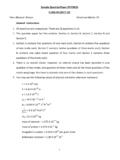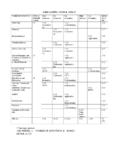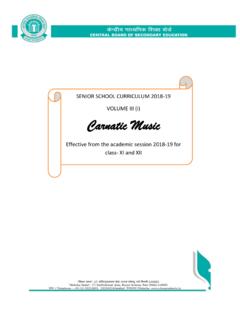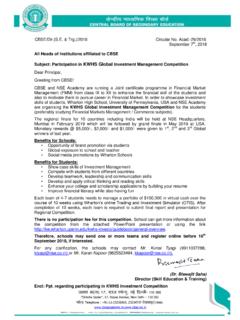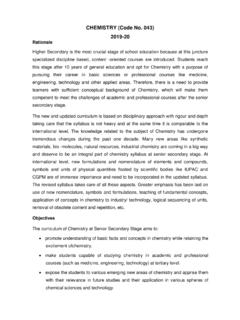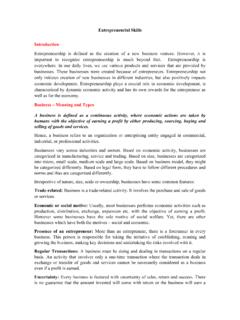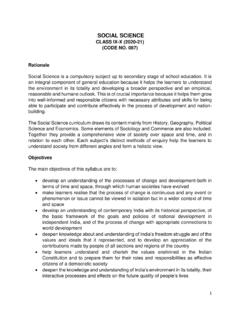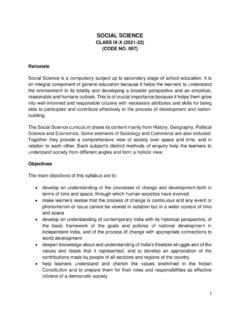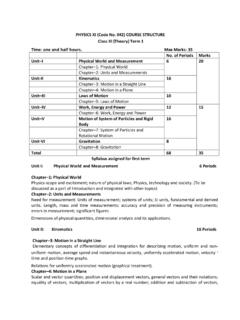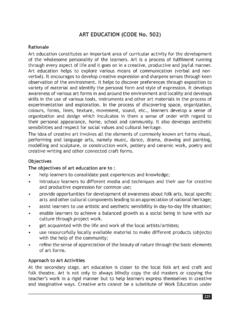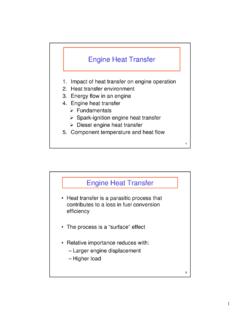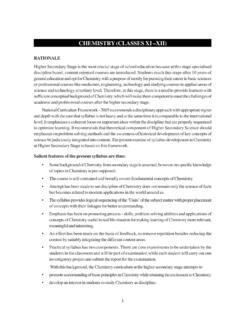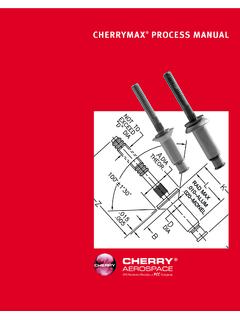Transcription of CLASS IX and X (2021-22)
1 Page 1 of 10 SCIENCE (Subject Code - 086) Syllabus for Purpose of Examination 2021-22 CLASS IX and X (2021-22) The subject of Science plays an important role in developing well-defined abilities in cognitive, affective and psychomotor domains in children. It augments the spirit of enquiry, creativity, objectivity and aesthetic sensibility. Upper primary stage demands that a number of opportunities should be provided to the students to engage them with the processes of Science like observing, hypothesizing, experimenting recording observations, drawing, tabulation, plotting graphs, analyze and drive conclusions etc.
2 , whereas the secondary stage also expects abstraction and quantitative reasoning to occupy a more central place in the teaching and learning of Science. Thus, the idea of atoms and molecules being the building blocks of matter makes its appearance, as does Newton s law of gravitation. The present syllabus has been designed around seven broad themes viz. Food; Materials; The World of the Living; How Things Work; Moving Things, People and Ideas; Natural Phenomenon and Natural Resources. Special care has been taken to avoid the temptation of adding too many concepts than can be comfortably learnt in the given time frame. No attempt has been made to be comprehensive.
3 At this stage, while science is still a common subject, the disciplines of Physics, Chemistry and Biology begin to emerge. The students should be exposed to experiences based on hands - on activities as well as modes of reasoning that are typical of the subject. General Instructions: 1. The total Theory Examinations (Term I+II) will be of 80 marks and 20 marks weightage shall be for Internal Assessment (Term I+II). 2. Internal Assessment - Maximum Marks 10 for each Term: a. There will be Periodic Assessment that would include: Three periodic tests will be conducted by the school in the entire session. Average of the two periodic tests/marks of best periodic Test conducted in the Term is to be taken for consideration.
4 Diverse methods of assessment as per the need of the CLASS dynamics and curriculum transaction. These may include - short tests, oral test, quiz, concept maps, projects, posters, presentations, enquiry based scientific investigations etc. b. Subject Enrichment in the form of Practical/Laboratory work should be done throughout the year and the student should maintain record of the same. Practical Assessment should be Page 2 of 10 continuous. All practicals listed in the syllabus must be completed. c. Portfolio to be prepared by the student- This would include classwork and other sample of student work.
5 COURSE STRUCTURE CLASS IX EVALUATION SCHEME Theory Units Term- I Marks I Matter-Its Nature and Behaviour: Chapter - 2 09 II Organization in the Living World: Chapter - 5 and 6 18 III Motion, Force and Work: Chapter - 8 and 9 13 Units Term - II Marks I Matter-Its Nature and Behaviour: Chapter 3 and 4 18 II Organization in the Living World: Chapter -13 08 III Motion, Force and Work: 10 and 11 14 Total Theory (Term I+II) 80 Internal Assessment: Term I 10 Internal Assessment: Term II 10 Grand Total 100 TERM I Theme: Materials Unit I: Matter- It s Nature and Behaviour Chapter 2 Is matter around us Pure Nature of matter: Elements, compounds and mixtures.
6 Heterogeneous and homogenous mixtures, colloids and suspensions. Theme: The World of the Living Unit II: Organization in the Living World Chapter 5 The Fundamental Unit of Life Cell - Basic Unit of life: Cell as a basic unit of life; prokaryotic and eukaryotic cells, multicellular organisms; cell membrane and cell wall, cell organelles and cell inclusions; chloroplast, mitochondria, vacuoles, endoplasmic reticulum, Golgi apparatus; nucleus, chromosomes - basic structure, number. Chapter 6 Tissues Page 3 of 10 Tissues, Organs, Organ System, Organism: Structure and functions of animal and plant tissues (only four types of tissues in animals; Meristematic and Permanent tissues in plants).
7 Theme: Moving Things, People and Ideas Unit III: Motion, Force and Work Chapter 8 Motion Motion: Distance and displacement, velocity; uniform and non-uniform motion along a straight line; acceleration, distance-time and velocity-time graphs for uniform motion and uniformly accelerated motion, derivation of equations of motion by graphical method; elementary idea of uniform circular motion. Chapter 9 Force and Laws of Motion Force and Newton s laws: Force and Motion, Newton s Laws of Motion, Action and Reaction forces, Inertia of a body, Inertia and mass, Momentum, Force and Acceleration.
8 Elementary idea of conservation of Momentum. TERM - II Theme: Materials Unit I: Matter- It s Nature and Behaviour Chapter 3 Atoms and Molecules Particle nature and their basic units: Atoms and molecules, Law of constant proportions, Atomic and molecular masses. Mole concept: Relationship of mole to mass of the particles and numbers. Chapter 4 Structure of Atom Structure of atoms: Electrons, protons and neutrons, valency, chemical formula of common compounds. Isotopes and Isobars. Theme: Moving Things, People and Ideas Unit III: Motion, Force and Work Chapter 10 Gravitation Gravitation: Gravitation; Universal Law of Gravitation, Force of Gravitation of the earth (gravity), Acceleration due to Gravity; Mass and Weight; Free fall.
9 Chapter 11 Work and Energy Work, energy and power: Work done by a Force, Energy, power; Kinetic and Potential energy; Law of conservation of energy. Theme: The World of the Living Page 4 of 10 Unit II: Organization in the Living World Chapter 13 Why do we fall ill Health and Diseases: Health and its failure. Infectious and Non-infectious diseases, their causes and caused by microbes (Virus, Bacteria and Protozoans) and their prevention; Principles of treatment and prevention. Pulse Polio programmes. ** ONLY FOR INTERNAL ASSESSMENT Note: Learners are assigned to read the below listed part of Unit IV.
10 They can be encouraged to prepare a brief write up on any one concept of this Unit in their Portfolio. This may be an assessment for Internal Assessment and credit may be given (Periodic assessment/Portfolio). This portion of the Unit is not to be assessed in the year-end examination. Theme: Natural Resources: Balance in nature Unit IV: Our Environment Chapter -14 Natural Resources Physical resources: Air, Water, Soil. Air for respiration, for combustion, for moderating temperatures; movements of air and its role in bringing rains across India. Air, water and soil pollution (brief introduction).
